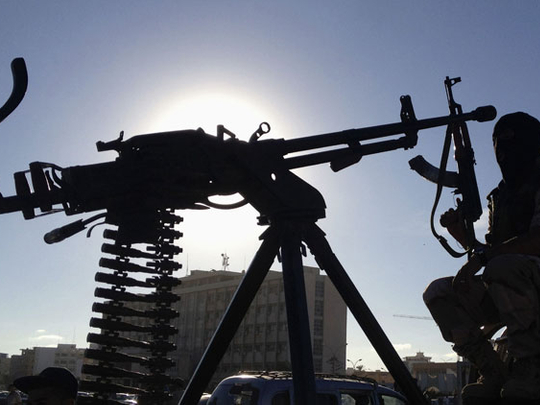
Dubai: Two years after a revolution ended Muammar Gaddafi’s 42-year rule, Libya is in turmoil, with its vulnerable central government and nascent armed forces struggling to contain rival tribal militias and Islamist militants who control parts of the country.
In the east of the country, Benghazi has several militias which were placed under the ministry of defence’s control by the Libyan National Transitional Council (NTC) in June 2011. However, the grouping called “the alliance of the battalions of the revolutionaries” did not include some of the more powerful militias, such as the now disbanded Ansar Al Sharia.
In the West of the country, militias accrued power and influence during the 2011 conflict when ex-army and navy personnel joined civilian volunteers to form armed combat groups. Two Tripoli militias, led by Abdullah Naqir and Abdel Hakim Belhaj, dissolved in 2012 and re-emerged as new political parties.
Martyrs of 17 February Brigade
The Martyrs of 17 February Brigade are considered to be the biggest and best armed militia in eastern Libya. The brigade is financed by the Libyan defence ministry. The brigade consists of at least 12 battalions and possesses a large collection of light and heavy weapons in addition to training facilities. Its membership is estimated at between 1,500 and 3,500. The group has carried out various security and law and order tasks in eastern Libya and Kufra in the south. Some of its members are also believed to be fighting the Al Assad regime in Syria.
Martyrs of Abu Salim Brigade
The Martyrs of Abu Salim Brigade, a group of former jihadists, were among the first to revolt against the Gaddafi regime in February 2011. The group’s Facebook page shows daily posts of letters from heads of schools and hospitals, either asking for protection from thieves and vandals or giving thanks. The brigade supervises community projects, such as the asphalting and repair of some roads in Darna, east of Benghazi, and appears to be the sole force of law and order there. There is no clear information about the group’s ideological position despite its clear Islamic tinge. The militia is named after the infamous Abu Salim prison, in which many Libyan Islamists perished under Gaddafi’s rule.
Martyr Rafallah Shahati Battalions
The Martyr Rafallah Shahati Battalions are named after one of the first Libyans to die while fighting Gaddafi’s forces in March 2011 in Benghazi. The group began as a battalion of the 17 February Martyrs brigade, before expanding to become a group in its own right. Its members are estimated at 1,000 with presence in eastern Libya and in Kufra. The brigade took part in securing the national elections and other Ministry of Defence operations in eastern Libya. It has denounced the killing of the US ambassador in Benghazi.
Libya Shield Force
The Libya Shield Force grouping of militias appears to be the most widely-deployed across Libya. Its appearance and conduct resemble that of a conventional army unit. The force reports to the Libyan defence ministry under the command of Wisam Bin Ahmad, who commanded a Benghazi brigade called “Free Libya Martyrs”. The force includes smaller militias from Misrata, Khums and other small towns in central Libya. The force is divided into three main brigades in eastern, central and western Libya and carries out law and order and combat tasks. On social media, reactions to the group are favourable across Libya in comparison to other militias, particularly over its charitable work.
Al Zintan Revolutionaries’ Military Council
The military council of the Zintan area is best known for detaining Saif Al Islam Gaddafi after his capture in November 2011. One of its leaders, Osama Al Juwali, is now the Libyan defence minister. The council was formed in May 2011 to organise military efforts of 23 militias in Zintan and the Nafusa mountains. It has five brigades, the most prominent one being the Martyr Mohammad Al Madani brigade, which boasts about 4,000 members. The council is currently led by Mukhtar Kalifa Shahub, a former Libyan navy officer. The group has various Arabic-language media outlets. These include a satellite channel called Libya Al Watan and several websites and pages on Facebook.
Sadun Al Suwayli Brigade
The brigade is part of Misrata’s Military Council, which includes other fighters from the coastal city. In addition to taking part in the liberation of Tripoli, the brigade is credited with having led the final assault on Sirte, Gaddafi’s hometown. Part of the brigade remained in Tripoli, where they occupied and provided protection to government buildings and facilities. It is commanded by Faraj Al Suwayli. It recently became part of the security services despite operating fairly independently of the government. The group was condemned in June for briefly kidnapping journalist Suleiman Dughah who had criticised Misrata’s militias.
Al Sawaiq Brigade
Originally from Zintan in the Nafusa mountains, Al Sawaiq took part in the assault on Tripoli in September 2011 and was tasked with protecting senior figures in the transitional government thereafter. Since then it has changed its name to Al Sawaiq Brigade for Protection. Al Sawaiq came under the authority of the ministry of defence in October 2012. The group’s size is unknown but it appears to be well-armed, especially with anti-aircraft guns mounted on its jeeps. Its commander is Imad Mustafa Al Trabulsi. Like other Libyan militias, Al Sawaiq shows signs of adopting moderate conservative Islam.
Al Qaqa Brigade
Al Qaqa brigade was formed by a group of Libyans from the west who trained in the Zintan area during the 2011 conflict. It is commanded by Uthman Muleiqithah who defected from Gaddafi’s regime after the 17 February revolt. The militia was tasked with the provision of law and order and the protection of senior officials and government ministers. The militia is officially under the authority of the defence ministry.
— Compiled from agencies













